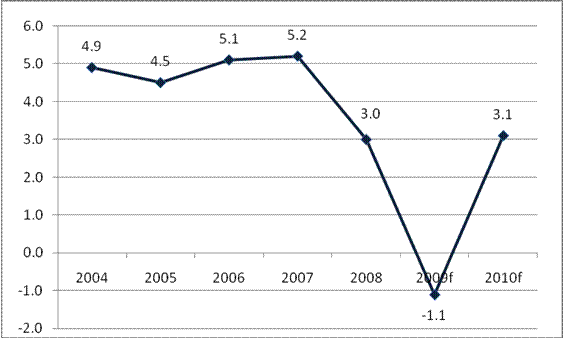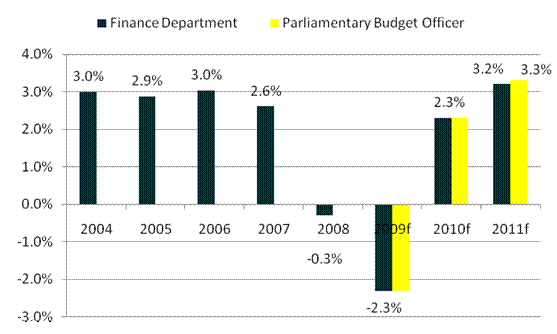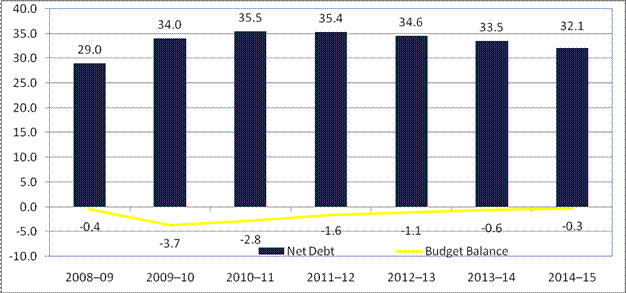FINA Committee Report
If you have any questions or comments regarding the accessibility of this publication, please contact us at accessible@parl.gc.ca.
|
CHAPTER 1: CANADA’S ECONOMIC AND FISCAL CONTEXT When the Committee released its most recent pre-budget consultation report in February 2008, the United States’ economy appeared to be entering a mild recession, but the global economy was strong and Canada’s real economic output for 2009 was expected to be 2.7%. Until that point, concerns were focused on such issues as sub-prime mortgages, commercial paper, derivatives, shadow banking, interbank lending rates and the current account deficit in the United States. There was relatively less concern about the overall health of the US and global financial systems. By early September 2008, Fannie Mae and Freddie Mac, the US government-sponsored entities that securitized mortgages to facilitate home purchases, were placed under government conservatorship. Later that month, Lehman Brothers filed for bankruptcy protection under the US Bankruptcy Code. Moreover, major US investment banks, including Goldman Sachs and Morgan Stanley, became bank holding companies that would be subject to greater government regulation and that would be able to take Federal Deposit Insurance Corporation-insured deposits. Over time, it became clear that a global financial and economic crisis was under way and, in the last quarter of 2008 and the first half of 2009, global economic output experienced its largest contraction since the end of the Second World War. Even though the United States was at the centre of the crisis, global financial markets and international trade meant that the crisis quickly spread around the world, leading to reduced economic growth. The International Monetary Fund (IMF) expects a global real economic contraction of 1.1% in 2009, as shown in Figure 1. Figure 1 — Global Real Economic Growth as a Percentage of Gross Domestic Product, 2004-2010
f=forecasts Source: International Monetary Fund, World Economic Outlook, October 2009, p. 169, http://www.imf.org/external/pubs/ft/weo/2009/02/pdf/text.pdf. In response to this global problem, a global solution has emerged. Major central banks have coordinated their efforts to provide monetary stimulus by lowering overnight interest rates and, in some cases, by introducing relatively unconventional monetary policy tools, such as “credit easing” and/or “quantitative easing.” Governments have responded with fiscal stimulus measures, both tax and program spending, and the IMF has sought coordinated fiscal stimulus equal to 2% of gross domestic product (GDP). The G7 finance ministers and central bank governors have made a commitment to prevent the failure of “systemically important” financial institutions; during the crisis, some of these countries’ governments purchased equity in their domestic financial institutions in an effort to prevent greater disruption in the financial system. While current monetary and fiscal actions have been important in bringing about an economic recovery, it is believed that actions must also be taken to prevent the recurrence of such a crisis. The G20 countries have committed to making a number of regulatory changes, and countries have agreed to reduce their current account imbalances. With respect to monetary policy, the G20 countries have agreed that price stability and market-based exchange rates are desirable. It has also been agreed that capital standards for financial institutions will be strengthened and capital ratios will be countercyclical, increasing with economic growth while decreasing with lower growth and during recessions. The G20 countries have also agreed to prevent regulatory arbitrage, to regulate the shadow banking sector and to reform the securitization market by requiring the issuer to hold a portion of the underlying assets, with implications for prudence and risk-taking behaviour. Within this global context, Canada—like many nations worldwide—has experienced a recession. According to the IMF, Canada’s federal, provincial and territorial governments have responded; over 2009 and 2010, federal fiscal stimulus is expected to equal 3.6% of the value of Canada’s GDP in 2007. According to the 2009 federal budget, the government’s fiscal stimulus measures will total an estimated $33.5 billion, excluding tax measures, over the 2009-2010 and 2010-2011 fiscal years. Spending will occur in five broad areas: the financial system (about $174 million), consumer spending (about $12.8 billion), housing (about $5.3 billion), infrastructure (about $10.8 billion), and businesses and communities (about $4.5 billion). The federal government has also provided financial support totalling about $11.8 billion, including loans and other measures, to communities and industries that include the automotive sector, as well as other capital spending, loan provisions and tax reductions. For its part, the Bank of Canada has lowered its target for the overnight rate, introduced the term purchase and resale agreement facility, and broadened the range of acceptable collateral to access overnight funds. As of October 21, 2009, the target for the overnight rate was 0.25%, down from 4.5% in November 2007, and the inflation rate as measured by the All-Items Consumer Price Index was -0.9% in September 2009. The outstanding value of the term purchase and resale agreement facility peaked at $37 billion in December 2008. The Department of Finance and the Parliamentary Budget Officer expect real GDP to decline by 2.3% in 2009, as shown in Figure 2. In 2010, positive real economic growth is expected to resume in response to the stabilization of financial markets and the global monetary and fiscal stimulus. Figure 2 — Growth in Real Gross Domestic Product, Canada, 2004-2011
f=forecasts Source: Statistics Canada, Table 384-0002; Department of Finance, Update of Economic and Fiscal Projections, September 2009, p. 15, http://www.fin.gc.ca/ec2009/pdf/bac-eng.pdf; Parliamentary Budget Officer, Economic and Fiscal Assessment Update, 2 November 2009, p. 10, http://www2.parl.gc.ca/Sites/PBO-DPB/documents/EFAU_November_2009.pdf. Recent tax reductions, a decline in federal tax revenues and the fiscal cost of stimulus measures have contributed to current and expected federal budgetary deficits from 2009-2010 to 2014-2015, as shown in Figure 3. For the 2009-2010 and 2010-2011 fiscal years, both the Department of Finance and the Parliamentary Budget Officer have projected relatively large federal budgetary deficits as a proportion of GDP, although deficits are expected to decline once the current federal fiscal stimulus measures expire at the end of the 2010-2011 fiscal year. According to the Department of Finance, federal budgetary deficits are expected to be 3.7% of GDP in 2009-2010 and 2.8% of GDP in 2010-2011; comparable figures for the Parliamentary Budget Officer are 3.6% and 2.7% respectively. Both the Department of Finance and the Parliamentary Budget Officer expect that net federal debt as a percentage of GDP will continue to rise until 2010-2011 before declining for the 2011-2012 to 2014-2015 fiscal years. Canada is expected to retain its position as the country with the lowest net debt-to-GDP ratio among the G7 countries. Figure 3 — Projections of the Federal Budgetary Balance and Federal Debt as a Percentage of Gross Domestic Product, 2008-2009 — 2014-2015
Source: Department of Finance, Update of Economic and Fiscal Projections, September 2009, p. 9, http://www.fin.gc.ca/ec2009/pdf/bac-eng.pdf. Within the context of the nation’s fiscal situation, some of the Committee’s witnesses spoke about the need for the federal government to avoid a structural deficit, and to develop—and communicate to Canadians—a viable plan for a return to balanced budgets at the earliest opportunity. In the view of a number of witnesses, short-term deficit financing should not be allowed to continue, and program spending—which should be reviewed regularly—must not rise at a rate that exceeds the rate of population growth and inflation. Moreover, witnesses said that spending should be “productive,” with documented value for the money spent and public accountability, and should not support industries that would fail in the absence of taxpayer support or be in areas that most Canadians do not want; a number of specific suggestions were made. In their view, tax increases should be avoided, and tax reductions were favoured over higher government spending. Witnesses also highlighted the need for the federal government to spend in a manner consistent with its constitutional jurisdiction, yet provide the provinces and territories with the support that they need. Other witnesses commented on the need to let the current stimulus spending “run its full course,” and to spend the funds in a timely and efficient manner directed to those most in need. From this perspective, additional stimulus spending should not be considered until the impact of the current spending has been measured, evaluated, reported to Parliament and subjected to public debate. Some argued that stimulus spending should be focused on short- to medium-term policies to alleviate job losses and/or declining output or cash flow, be based on empirical evidence and not add unduly to the complexity of the tax system or the compliance burden on taxpayers. The Committee was also told that net domestic product, rather than GDP, should be used when reporting economic growth or decline, and that measurable indicators of social health and citizen happiness should be used alongside economic growth as “generators of prosperity.” It was also suggested that pre-budget submissions should include a social impact study as well as a plan to mitigate negative social consequences. As well, the Committee was informed that the federal bureaucracy should be reduced in size. A number of specific suggestions were made: reduce the size of the Prime Minister’s Office and the Cabinet, in part by eliminating minister of state positions; combine federal departments and agencies, as appropriate; and reduce the size of the federal public service. On the other hand, some witnesses urged an end to excessive federal outsourcing, which presumably would be inconsistent with reducing the size of the public service. The Committee agrees with those witnesses who advocated debt management, expenditure restraint, and transparency and accountability as the nation continues to recover from the global financial and economic crisis. In our view, Canada entered the crisis from a relative position of fiscal strength and sound financial regulation. Consequently, when the crisis occurred, the nation was able to implement the tax and spending stimulus measures needed to assist the economy recovery. However, as in other countries, the stimulus spending that has occurred was meant to be temporary in duration, and we support its short-term nature. Once the economic recovery has been assured, we believe that positioning the nation for the future will require a focus on sound fiscal management and on debt reduction. We also feel that Parliamentarians will need to have independent information with which to assess the extent to which these priorities are being met. From this perspective, the Committee recommends that: The federal government continue with full implementation of current stimulus measures, pay close attention to debt management, engage in meaningful expenditure review and prepare long-term debt reduction plans to be implemented once the global economic recovery is fully entrenched. Moreover, the government should ensure that the Library of Parliament’s Parliamentary Budget Officer has timely and accurate information related to federal tax revenues, program spending and departmental program objectives, provide the Parliamentary Budget Officer with the necessary resources to carry out the mandate of the office effectively, and—as part of the legislation to implement the next federal budget—propose the legislative amendments needed to establish the Parliamentary Budget Officer as an independent officer of Parliament. |


